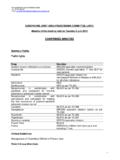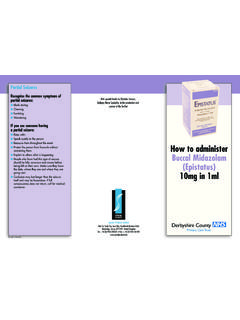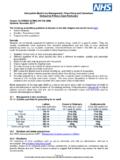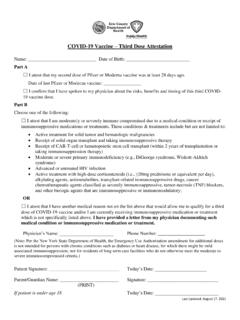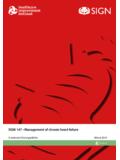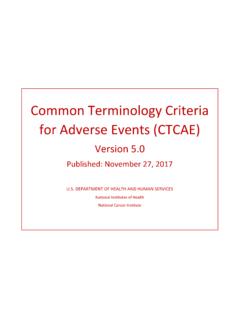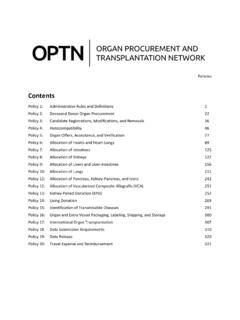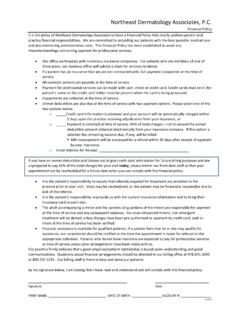Transcription of MANAGEMENT OF HEART FAILURE with Reduced Ejection …
1 Updated: January 2019 Review date: December 2021 Page 1 of 28 MANAGEMENT OF HEART FAILURE with Reduced Ejection Fraction (HFREF) All patients with HFREF should be considered for an ACE inhibitor and beta blocker. Introducing one drug at a time, and once the person is stable on the first drug (usually an ACE) then adding the second drug. Aim for the target dose of ACE inhibitor and beta blocker; or, failing that, the maximum tolerated dose. Patients with HEART FAILURE with Reduced Ejection fraction who have ongoing symptoms of HEART FAILURE , despite optimal treatment, should be given mineralocorticoid receptor antagonists (MRA) spironolactone as first line option. No patient should receive three drugs which block the renin-angiotensin-aldosterone system as hyperkalaemia and renal dysfunction will be common. The safety and efficacy of combining an ACE inhibitor, an ARB and MRA is uncertain and the use of these three drugs together is not recommended.
2 Monitoring renal function has a very important role in HEART FAILURE MANAGEMENT . This should be done 6 monthly in stable patients, and more frequently when there is change in drug treatment and/or an acute change in the patient s condition. Monitor response to titration of medications closely in CKD taking into account increased risk of hyperkalaemia. If eGFR <45ml/ consider lower doses and/or slower titration of dose of ACEI or ARB, MRA & digoxin. NTproBNP testing is used to screen patients (without an MI) before referral for ECHO in patients with suspected HEART FAILURE . If ECHO suggests a diagnosis of HF an ECG should be done (if not already) to help identify the underlying cause of the HF. Sacubitril valsartan is a treatment option to be used as per NICE TA 388. Treatment with sacubitril/valsartan is initiated by specialist and may be continued under shared care.
3 Patients who commence treatment will have their ACE or ARB discontinued at least 36 hours before treatment is started. (See appendix 3 for further details) Dapagliflozin is recommended as a treatment option as per NICE TA679. Treatment with dapagliflozin should be initiated by the specialist and stabilised before transferring the patient to primary care. Not to be used in patients with type 1 diabetes. Counsel patients on sick day rule. (See MANAGEMENT algorithm and appendix 4 for further details, including Patient information leaflets by Trent Diabetes, or PIL produced by manufacturer which can be downloaded from website by a Healthcare professional) Specialist advice should be sought for patients who deteriorate after having been stable for a number of years on optimum pharmacological treatment with an unaccountable cause. DERBYSHIRE JOINT AREA PRESCRIBING COMMITTEE (JAPC) Updated: January 2019 Review date.
4 December 2021 Page 2 of 28 INDEX Page Key recommendations 3 Investigations/ Diagnosing HEART FAILURE 4 MANAGEMENT algorithm - HFREF 5 Drug therapy o Diuretics 6 o ACEI 6 o ARB 7 o First-line MANAGEMENT of HFREF 8 o B-blockers 9 o MRA 10 o Prescribing tips 12 o Ivabradine 13 o Sacubitril/valsartan 13 o Dapagliflozin 14 o Digoxin 14 o Aspirin & a statin 14 Lifestyle advice 14 References 15 Consultees 15 Further Resources 15 Appendix 1 PIL for ACEi 16 Appendix 2 PIL for beta-blockers 18 Appendix 3 Algorithm for the use of sacubitril/valsartan 20 Appendix 4 - Algorithm for the use of an SGLT2 inhibitor (Dapagliflozin) 21 o Prescribing notes for dapagliflozin 22 Appendix 5 -- DCHS HEART FAILURE Specialist Service 25 GP Referral Form for patients with HFREF 26 Appendix 6 -- PIL medicines and your kidney 28 Document update Date updated updated to remove recommendation to refer all HEART FAILURE to specialist team April 2019 Dapagliflozin as per NICE TA679.
5 Prescribing information added April 2021 Key ACEi angiotensin converting enzyme inhibitor ARB angiotensin receptor blockers BNP B-type natriuretic peptide CRT cardiac resynchronisation therapy eGFR estimated glomerular filtration rate ECG Electrocardiogram FBC full blood count HFREF HEART FAILURE with Reduced ejections fraction HR HEART rate ICD implantable cardiovascular defibrillators LFT liver function test LVEF left ventricular Ejection fraction MRA mineralocorticoid receptor antagonist NTproBNP N-terminal proB-type natriuretic peptide RAS renin angiotensin system SBP systolic blood pressure TFT thyroid function test U&Es serum urea & electrolytes Updated: January 2019 Review date: December 2021 Page 3 of 28 Definition HEART FAILURE with Reduced Ejection fraction (HFREF)- HEART FAILURE with an Ejection fraction below 40% 1. Key recommendations Investigation/ diagnosis Patients with suspected chronic HEART FAILURE should receive a range of basic tests.
6 The investigations chosen will vary depending on the presentation but should usually include o NTproBNP o ECG o chest X-ray o Blood tests: renal function (electrolytes, creatinine, eGFR), FBC, TFT, LFT, HAB1c, lipids o urinalysis o peak flow or spirometry The basis for historical diagnoses of HEART FAILURE should be reviewed, and only patients whose diagnosis is confirmed should be managed in accordance with this guideline. Transthoracic echocardiography should be performed to exclude important valve disease, assess the systolic function of the left ventricle and detect intracardiac shunts. Monitoring All patients with HEART FAILURE are at risk of renal impairment and hyperkalaemia. This is a consequence of common co-morbidities ( diabetes), drug treatment, or just of the HEART FAILURE itself. Monitoring renal function has a very important role in HEART FAILURE MANAGEMENT .
7 Measure at frequent intervals when there is a change in drug treatment or an acute change in the patient s condition. HEART FAILURE treatment, especially the combination of ACEi and MRA puts the patient at risk of acute decline in renal function and hyperkalaemia. Check renal function every 6 months when patients are clinically stable and on stable doses of medication. In the event of intercurrent illness, especially diarrhoea and vomiting, all patients should be counselled to contact their GP and to stop the ACEi and MRA (normally for 48 hours), until they have had a blood test or once they are better and taking oral fluids. See appendix 5 Medicines and your Kidneys patient information leaflet on sick day rules. Monitoring (minimum of 6 monthly for stable patients) should include: a clinical assessment of functional capacity, fluid status, cardiac rhythm, and cognitive and nutritional status a review of medication, including need for changes ( cessation of negatively inotropic calcium channel antagonists verapamil, diltiazem) and possible side effects U&Es and eGFR In patients that do not respond to treatment, an assessment and referral for escalation of therapy may be required either to a HF specialist nurse service or cardiology.
8 Discharge Patients with HEART FAILURE should generally be discharged from hospital only when their clinical condition is stable and the MANAGEMENT plan is optimised The primary care team, patient and carer must be made aware of the MANAGEMENT plan. Supporting patients and carers MANAGEMENT of HEART FAILURE should be seen as a shared responsibility between patient and healthcare professional. Consider referral to a specialist HEART FAILURE nurse if appropriate: (see appendix 4 referral form) Chesterfield link - 01246 253061 Derby link - 01332 564879 Updated: January 2019 Review date: December 2021 Page 4 of 28 2. Investigation/ Diagnosing HEART FAILURE Be aware that obesity, African or African Caribbean family origin, or treatment with diuretics, ACE inhibitors, beta blockers, ARBs or MRAs can reduce levels of serum natriuretic peptides.
9 Therefore, when questioning the diagnosis in patients on treatment either stop their medication for three days before taking the test or leave on treatment and get an ECHO. While awaiting referral and if symptoms are severe to warrant treatment (but not admission) start a loop diuretic furosemide 20-40mg per day. Stop if possible oral NSAIDs (including OTCs) or calcium channel blockers ( verapamil, diltiazem) NEW YORK CLASSIFICATION Class Symptoms I No limitation: ordinary physical exercise does not cause undue fatigue, dyspnoea or palpitations. II Slight limitation of physical activity: comfortable at rest but ordinary activity results in fatigue, palpitations or dyspnoea. III Marked limitation of physical activity: comfortable at rest but less than ordinary activity results in symptoms. IV Unable to carry out any physical activity without discomfort: symptoms of HEART FAILURE are present even at rest with increased discomfort with any physical activity.
10 NT-proBNP >2000 ng/L or pregnant patients with HF (if admission not indicated) Measure NT-proBNP HEART FAILURE unlikely consider other diagnosis NT-pro BNP <400 ng/L Refer for urgent Echo To be done within 2 weeks Take a detailed history and perform a clinical examination to evaluate for possible aggravating factors and to exclude other conditions with similar presentations Patients with suspected chronic HEART FAILURE should receive a range of basic tests. The investigations chosen will vary depending on the presentation but should usually include: NTproBNP, ECG, chest X-ray, blood tests (U&E, FBC, TFT, LFT, HAB1c (or fasting blood glucose), lipids), urinalysis, and peak flow or spirometry. NT-pro BNP 400-2000 ng/L Refer for urgent Echo To be done within 6 weeks Upon confirmation of HF GP can commence appropriate treatment Seek specialist advice/ referral if any problem arises Updated: January 2019 Review date: December 2021 Page 5 of 28 3.
